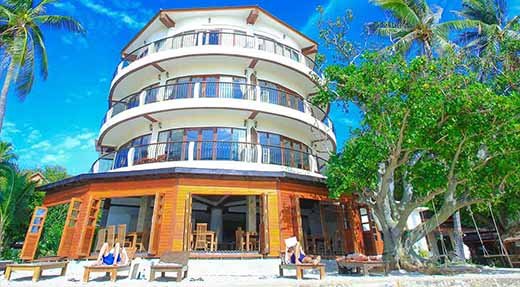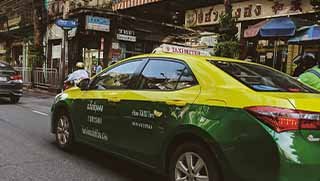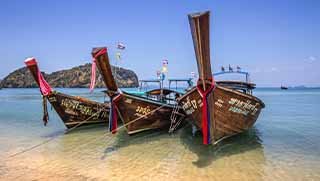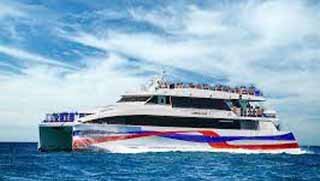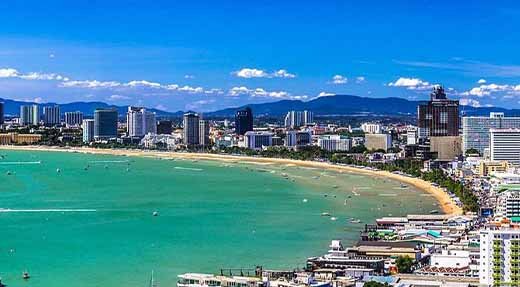Why Thailand is so popular for scuba diving
Thailand, the “Land of Smiles” located right at the heart of Southeast Asia is famed for its unique culture and internationally renowned cuisine. The country boasts incredible beauty with stunning peaks in the north, surrounded by lush tropical jungles. Further to the south palm trees fringe beautiful white sandy beaches,
and amazing colourful coral reefs are teeming with life below the surface.
Thailand also has many exhilarating cultural attractions right across the length and breadth of the country.
With the Gulf of Thailand on the East and the Andaman Sea on the west of Thailand, there are lots of scuba diving opportunities suited to all levels and interests, including coral reefs, drop offs, shipwrecks, walls and deep pinnacles.
Once finished diving for the day you will find plenty of entertainment from picturesque sunsets and excellent dining to social drinking and lively full moon parties.
Travelling to Thailand is easy!
Thailand is a traveller’s hotspot and the most popular tourist destination in Southeast Asia for good reason. Thailand is a large country, with so much to see and do whether hiking in the north, visiting Elephant sanctuaries in Chang Mai or scuba diving in the Gulf of Thailand down south.
Most visitors arrive at one of Bangkok’s two international airports, Suvarnabhumi International being the main hub airport and South East Asia’s busiest or its predecessor Don Muang which was reopened to International flights due to demand.
Other International airports, located on the island of Phuket on the west coast, and Koh Samui on the east are well served by international airlines. Prices vary depending on where you want to travel, but there are plenty of different options, with more and more flights being added after many routes were halted in the pandemic.
Once here, you will find Thailand has a great transport network and infrastructure making it easy for you to get around the country whatever your budget.
Planes, trains and automobiles
Flights in Thailand
The quickest, most comfortable and easiest way to travel Thailand is by domestic flights
and on the whole it’s not too expensive either.
There are plenty of domestic operators who compete for customers, meaning plenty of low fares and if you do some research, and plan ahead, it is possible to fly anywhere in the country for less than 2000Baht.
Travel by Bus in Thailand
Generally speaking buses are the best option for both price and comfort when travelling around the country. There are Government run buses called BKS that run to every province in Thailand.
There are also private bus companies such as Lomprayah, which operate out of Khao San Road in Bangkok. Lomprayah offer combined bus and ferry tickets that offer great value for money when travelling to Koh Tao, Koh Phan Ngan and Koh Samui.
They also operate services further south to Surat Thani and if you want to take your time on the journey down to the islands why not stop off at Hua Hin or Chumphon.
Travel by Train in Thailand
The state railway of Thailand has a network that covers most of Thailand from the north down to the South where you can connect all the way from Malaysia to the Northern border with Laos.
Most travellers use the sleeper/overnight services when travelling to or from Bangkok, or further north from Bangkok up to Chiang Mai. This saves on accommodation costs and makes travelling by train a popular choice for backpackers who are travelling the country or region extensively, over several months.
When compared to other forms of transport, Thailand trains are relatively slow and prone to delays. But they have modernised their carriages making them comfortable and do give extra freedom to move around.
Travel by Ferry in Thailand
Travelling between the islands and mainland around the Gulf of Thailand is very easy due to modern,
air-conditioned speedboat services. Regular departures go between the islands on a daily basis, making it easy to island hop when travelling through the region.
The ferry companies usually have a bus network that links in with their schedule, meaning you can get a joint bus and boat ticket from your area of departure. Companies such as Lomprayah have local offices in most cities and work with local travel agents making it easy to purchase tickets.
Thailand has a Warm & Tropical Climate
Thailand is a tropical country meaning for most of the year it is hot and humid with high temperatures. The country is governed by three seasons: rainy, caused by the southwest monsoon, cool and hot. The rainy season is the least predictable of the seasons.
This doesn’t mean it will rain all day every day but expect it to rain most days for a period of time. The rest of the day tends to be warm and often sunny. The air temperature will vary between 25°C to 35 °C depending on the location and the season.
The timing of these seasons is variable by where you are in the country. The north of Thailand and the west coast have a much earlier monsoon season (May to October), than that of the south and east coast which generally begins a little later. This is because the area in the Gulf of Thailand lies outside the general climate pattern due to the sea immediately to the East. The coastal areas and islands in this region feel the effects of the northeast monsoon, bringing a rainy season between October and January with November being the wettest.
In these areas rainy season is less severe than the Andaman coast suffering less rain and for a shorter period. This is why Koh Tao is able to dive 12 months of the year.
Great locations
You are literally spoilt for choice in Thailand, with many great locations as options for you
to take a PADI course with the majority being in the South of Thailand.
Koh Tao Island
Located in the Gulf of Thailand this little island is the number 1 place in the world
to get your PADI diving licence and continue your scuba diving education.
More people come here to get their PADI than anywhere else, a combination of low prices, great dive sites and wonderful marine life have made this island the place to go when travelling Thailand and wanting to go scuba diving.
This area is known to be the cheapest place in Thailand (and all of Asia) to take your PADI courses and the best place to see Whalesharks especially in recent years where these friendly giants have been spotted more frequently than at any other time.
Phuket
The largest Island in Thailand, Phuket is situated on the west coast along the Andaman Sea. Phuket rates among the top 10 scuba diving destinations in the world. Spectacular reefs, unusual underwater rock formations, and a huge variety of marine life provide great opportunities for divers at all levels and seasonal sightings of Whalesharks and Manta Rays.
Pattaya
Located an hour away from Bangkok, Pattaya is a coastal town that was the birthplace of scuba diving in Thailand. The diving is conducted around nearby islands, Ko Larn, Ko Sak, Ko Krok.
Nowadays the diving off Pattaya is famed for its numerous wrecks: the HTMS Kut, HTMS Kram and the Harddeep shipwreck as well as its strong currents.
Koh Phi Phi
The Island made famous by “The Beach” movie offers the most amazing beaches, coral reefs and amazing marine life in a very scenic surrounding. Situated in the South of Thailand Koh Phi Phi is actually a cluster of small islands in the Andaman Sea to the South of Phuket and is best visited October to April.
Year-round diving
A big question is when is the best time to dive in Thailand?
Thailand has two main diving zones, the Andaman Sea on the West coast and the Gulf of Thailand on the East Coast with each having a different main diving season. But it is possible to dive both areas all year round due to Thailand’s warm climate and variety of dive sites.
The water temperature ranges from 25°C to 30°C all year round depending on the weather and season, which means that you do not have to wear big thick wetsuits or dive in dry suits. The average visibility in this region is 10m to 40m with different factors having an effect on the range.
Gulf of Thailand
It is possible to dive Koh Tao all year round with a large range of dive sites available, almost all very local to the island. The best time to dive Koh Tao runs from Feb/March through to August with excellent conditions above and below the water.
Long sunny days, calm seas and great visibility enable divers to enjoy great diving conditions when taking their PADI courses. Traditionally, the best time to spot Whale Sharks around Koh Tao runs between February and May when there is a higher concentration of plankton in the water that the Whalesharks feed on, although they have been known to grace the island with their presence all year round.
Quality of training
PADI (Professional Association of Diving Instructors) is the world’s largest and most recognised scuba diving training agency with the most solid system of diver education available. Their training courses are all performance based and not time based meaning all students can learn at their own pace and not feel pressured.
PADI training courses are designed to make learning fun, enjoyable and productive for the students. All PADI programs, from entry-level courses up to professional and have high standards that are monitored for worldwide consistency and quality.
The basics of diving physics and physiology are introduced during beginner courses with the more in-depth details of these concepts being left for later courses. Each PADI course is designed to build on the previous one, improving your skills and techniques to be a better scuba diver.
PADI Diving Courses for every level of diver
PADI Open Water – This is the world’s most popular and widely recognised scuba diving course. Millions of people have learned to scuba dive through the PADI Open water course and gone on to discover the wonders of the marine world having unforgettable experiences through this course. Completing this course will certify you to dive anywhere in the world to a depth of 18 meters.
PADI Advanced Open Water – Designed to advance your diving and build on the skills that you have previously learnt on your beginner course, you can start immediately after completing the Open Water certification.
This course will add confidence and expand your scuba skills through different Adventure Dives including Deep diving, underwater Navigation and Night diving. When completed you are certified to dive to a depth of 30m.
PADI Rescue Diver
A course for more experienced divers in which you learn how to prevent and manage problems in the water, and become more confident in your skills as a diver. During the PADI Rescue diver course, you learn to become a better buddy by practicing problem solving skills until they become second nature. It is a challenging but extremely fun course to take.
PADI Divemaster
The PADI Divemaster course is the world’s most popular professional level scuba diving course. The first professional level in the PADI System of diver education you will enhance your dive knowledge,
management and supervision abilities so you become a role model to divers.
You will be taught how to become a leader and take charge of diving activities
enabling you to make a career through scuba diving.
© Crystal Dive Koh Tao

